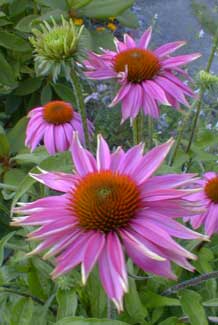
'Kim's Knee High' Coneflower:
"'Tis but a little faded flower,
But oh, how fondly dear!
'Twill bring me back one golden hour,
Through many a weary year.
I may not to the world impart
The secret of its power,
But treasured in my inmost heart,
I keep my faded flower."
-Ellen Clementine Howarth
(1827-1899)
(1827-1899)
I. Summer brilliance descending into winter intrigue
I'm a great fan of echinaceas now, but time was that I did not fully appreciate them. They looked like a pumped up daisies but with petals so droopy they seemed like they'd started to wilt.Then one long-ago year in putting together a roadside low-maintenance sun-garden, I wanted some flowery things that enjoyed somewhat harsh conditions. Echinaceas seemed to be the thing, & have rarely disappointed. I began to like them more & more, & ended up planting increasing varieties in various gardens.
They're ideal as butterfly attractants, make superb cuttings for bouquets (though to tell the truth they last longer left in the garden than when put in a vace), & bloom for an extremely long time. So my originally tepid interest in them heightened with observation until by now I feel like I'm somewhat an echinacea fanatic & adore them the way some people adore roses.
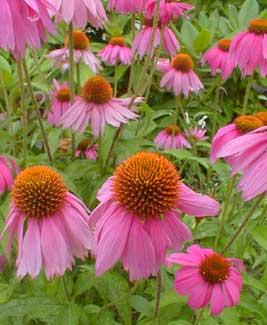 Some echinaceas develop six-foot-tall stems of flowers & these are a bit too big for our small gardens, so I selected primarily semi-dwarf varieties. The one shown on this page is Echinacea purpurea 'Kim's Knee High' which stays around two or three feet tall. The large flowers are not reduced in size, having deep pink petals & bright orange center cone.
Some echinaceas develop six-foot-tall stems of flowers & these are a bit too big for our small gardens, so I selected primarily semi-dwarf varieties. The one shown on this page is Echinacea purpurea 'Kim's Knee High' which stays around two or three feet tall. The large flowers are not reduced in size, having deep pink petals & bright orange center cone.It flowers pretty much continuously in summer & autumn, some years right up to December, so certainly justifies itself in flower power. The first photo above shows the blooms in June (2004) & the second is from July (2005). The fifth photo (below) is from August (2002).
When the petals are spent on the flowers, the centers remain as decorative cones, hence the common name Coneflower. The cones will last through the winter, or can be cut & dried & kept indefinitely in bouquets.
When the cones are in full seed, birds & especially finches will gather the seeds by clinging to the stem & pecking at the cones. The cones may also self-seed so that Coneflowers pop up where not expected, & may need to be dug up & moved to spots where they are wanted, or given away to chums.
One of the things that interests me about echinacea is how it deteriorates in winter, as the hardiest varieties, including 'Kim's Knee High,' never quite go entirely dormant here in Zone 8.
Not many garden websites are apt to show them in winter, because to say the least that's not when they're their most brilliant; but I'm breaking with tradition of showing them exclusively at their best, so that their lesser but distinct winter beauty can become better appreciated.
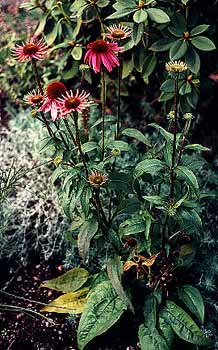 Many gardeners will elect to cut them back late autumn or early winter when they are largely finished blooming, & the clumps will grow back fresh & new the following mid to late spring & pick up blooming again in summer. As for me, I've not minded that their winter appearance is a mite grubby.
Many gardeners will elect to cut them back late autumn or early winter when they are largely finished blooming, & the clumps will grow back fresh & new the following mid to late spring & pick up blooming again in summer. As for me, I've not minded that their winter appearance is a mite grubby.I find a bit of decay in the garden interesting, whether that decay is in the lingering burst seedpods of sundry perennials that self-seed in autumn then dry out, or of maple leaves transforming into leafmold right where they fell, or semi-evergreens that only partially die back, & so forth.
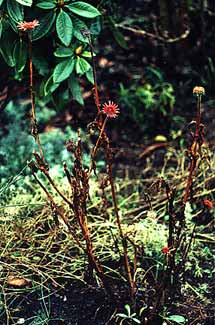 The third photo (at left) shows 'Kim's Knee High' in November, when it is still attempting to produce full-blown flowers, but is at the same time thinking about dying back for winter.
The third photo (at left) shows 'Kim's Knee High' in November, when it is still attempting to produce full-blown flowers, but is at the same time thinking about dying back for winter.Whatever parts of the clump get really bad looking I prune out, so the clump gets smaller & smaller, but surprisingly it even so sends up new stalks attempting to keep blooming.
In December through February, it still has interest for the half-aborted stunted blooms that look like sunburst starfish, the petals never completely filling out, the cold weather prohibiting the blooms from quite completing themselves. The unfinished blooms are even so very pretty.
The fourth photo (at right) was taken February. By now the clump is totally worn out, but the half-aborted flowers still have color! By late February new basal foliage is beginning (on this clump anyway, which is earlier than most), & whatever little bit of the previous year's growth is still alive should be cut back to make room for rapid new growth.
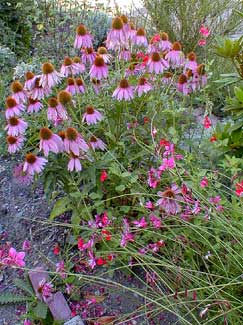 This pair of winter-photos are from 2002/2003. The winter of 2003/2004 was much harsher & the coneflowers too soon looked horrid & were clipped back. But each year I wait as long as possible so as to observe their winter behavior. Some years it's time to say goodbye to their blackening remnant by November, but for a milder winter there will still be some lingering liveliness at the end of February.
This pair of winter-photos are from 2002/2003. The winter of 2003/2004 was much harsher & the coneflowers too soon looked horrid & were clipped back. But each year I wait as long as possible so as to observe their winter behavior. Some years it's time to say goodbye to their blackening remnant by November, but for a milder winter there will still be some lingering liveliness at the end of February.There are many other perennials that can be induced to have a tepid winter presence, including several kinds of penstemons & campanulas & shrubby sages. In the majority of species, encouraging winter growth means they will not be as strong come spring, & it might have been better had they been cut back no later than late autumn, so that the energy stored in the roots isn't wasted before the serious growing seasons returns.
In colder zones, of course, this isn't an option, & winter growth oughtn't be encouraged. The comparatively or potentially delicate hybrids echinacias I would never attempt this with. But the sturdiest old standards, it's fun to observe their winter efforts.
But I've not found that an established clump of echinacea suffers too much from being permitted this lesser winter presence, as no matter what, they'll be in full glory by the following June or July.
So its winter presence can even with partial decay be aesthetic, & the bird-feeding cones need not be deadheaded until they soften with decay, & new winter growth resulting in only half-finished winter flowers is intriguing to observe.
Coneflowers can be grown down to zone 3 or 4, but of course in these colder zones the clumps will definitely undergo complete winter die-back.
The second fifth photo (on the left) shows 'Kim's Knee High' near the end of August (2003), still conveying its primary summer-long showing. Also visible is an everblooming Gaura 'Siskiyou Pink.' Plus the evergreen leaves of Rhododendron 'Anna Rose Whitney' can be seen at the edges or background of three out of four of this page's echinacea portraits. The sixth photo (below) shows the same clump in July (2004) with a bee that has gone to sleep on one of the flowers at dusk.
Other semi-dwarf cultivars include E. p 'Ruby Star' which is awfully similar to 'Kim's Knee High' but begins blooming a bit later; & E. p. 'White Swan' which has white coneflowers so stands out most distinctly. There are many-many others, & new dwarf or semi-dwarf varieties are being introduced almost every year, as we are presently in the midst of a new explosion of interest in new hybrids with improved scent or unusual colors or double-flowered or semi-doubles. It's a great moment in history to be an echinacea fan.
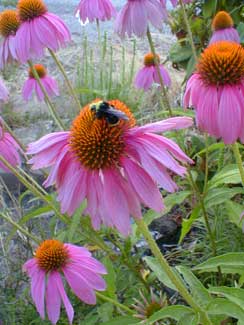
II. Echinacea & herbal quackery
Although herbal quacks will forever claim otherwise to keep their customers, & herbal hypochondriacs will forever believe it helped them just fine, Echinacea angustifolia, E. pallida & E. purpurea are among the herbs that have undergone the best-designed most-rigorous trials, & it's pretty clear it is as close to worthless as any herbal remedy can be.I am always on the look-out for herbs that aren't phony & for some years I kept echinacea on the "it works!" side of the ledger, but only because so many friends swore by it -- in some cases friends who also swore by smell-therapy or who believed putting their head inside a box of colored lights would improve their IQs.
The only real way to establish efficacy is by double-blind placebo-controlled studies, & eventually I got round to pulling down as many scientific articles on the topic as I could, & what a disappointment to discover that echinacea really does belong on the "phony" side of the ledger.
The June 2000 issue of Antimicrobial Agents & Chemotherapy reports a typical study on echinacea's alleged influence on the common cold. 117 people received either echinacea or a placebo for two weeks, then were exposed to cold viruses. Those who took the echinacea caught colds at the same rate as those who took placebos. Other research even indicates that taking echinacea regularly may weaken resistance to the common cold, but more certainly it has no bonus effect beyond that of placebo.
The January 2002 issue of Annals of Allergy, Asthma, & Immunology reports on research that did find one potent area for echinacea. It is one of the most common herbs to induce allergies & asthma attacks. So the belief that it fights off respiratory illness actually is the opposite of reality.
Another study reported in the December 3, 2003 issue of the Journal of the American Medical Association, compared incidents, duration, & severity of the common cold in 407 children in two groups, those treated with echinacea for colds, & those given placebos. The two groups were identical in incident, duration, & severity. Echinacea provided only one bonus: 7% of the children had allergic reactions to the echinacea, so it benifited none, & made matters worse for a minority.
The December 17 2002 issue of Annals of Internal Medicine reports on a study done at the University of Wisconsin Madison Medical School, with 20-year-old college students as volunteers. Two species of echinacea were tested. There was no difference in duration & severity of the common cold in the group using echinacea vs the group using a placebo.
Some studies are misrepresented by vendors as proving benefits when the studies actually proved a benefit equal to a placebo.
Many seriously misguided naifs even impose such fake medicines on pets who cannot gain by even the placebo effect, having as they do no such thing as a "belief" in echinacea's medicinal potency.
The "best case" study comes from Mark Blumenthal, director of the American Botanical Council. Although this is an herbal advocacy group, they are independent & do not have any direct connection with any manufacturer of herbal products. Blumenthal also teaches medicinal chemistry at the University of Texas College of Pharmacy.
When he oversaw a study of two species of echinacea, they discovered the leaves were worthless as a cold suppressant, but found tentative evidence that a concentrated extract of the root might shorten the duration of common colds. Better designed studies would in the years to follow show pretty conclusively this isn't so, but there for a moment it seemed at least vaguely plausible, which is what vendors & promoters latch onto.
Although no preparation available in healthfood stores was ever restricted to concentrated extracts from roots, the vendors nevertheless relied on Blumenthal's tepid evidence, even when selling leaf matter that even Blumenthal found to be without merit.
When later studies indicated that the never-certain findings of restricted value for the roots don't hold up to closer scrutiny, of course vendors still cited only on the older & irreprodicible information.
The University of Wisconsin study also included an analysis of 250 other studies, among which an unimpressive 13 studies were like the American Botanical Council findings, none showing conclusive value, but leaving a few slight loopholes for optimism. The vast majority of the studies did not have the mixed result that permits faith-driven believers in echinacea to keep fooling themselves.
The benefit that is marginally plausible is due to antioxidants in chemical compounds of the roots (not to be found in powdered or liquid extract echinacea however). The claim that echinacea contains healthful antioxidants is true if one is speaking only of the roots, though there are even more antioxidants in a russet potato or a strawberry or a pecan nut or most famously a blueberry.
Antioxidants do indeed provide immunity-boosts, & herb vendors rely on studies that inconclusively hint at this immunity benefit from echinacea, while ignoring the greater number of studies that would not make such good advertisements when making the sales pitch to herb-sucking rubes. And bare in mind even the best-case studies would make echinacea no more useful for its antioxidants than eating a potato.
Now Ma-huang or "natural ephidrin" is a powerful herb for treating cold congestion. And therefore banned or restricted for use, because herbs with legitimate potency also have dangerous side effects, sufficiently severe with ma-huang that it is associated with incidents of death & psychosis (from misuse, however, as a diet aid). People who misused the drug have made it difficult to obtain for proper use. Its misuse was encouraged by aggressive vendors, who simply never have the public health in mind.
What is promoted commercially tends to be the most worthless stuff. Although their fake medicines having no effect beyond that of a placebo, they tend also to have few if any side effects, & can be "safely" recommended by that otherwise unemployable check-out teller at the health food store who has become so many people's prescribing physician.
Cleanliness, well-balanced diet, & exercise are far more beneficial than the sort of powdered or liquescent garden-rubble superstitious people eagerly mistake for medicine.
Continue to:
'Ruby Star' Echinacea